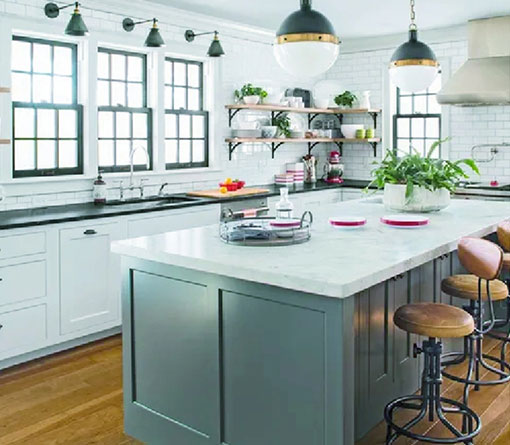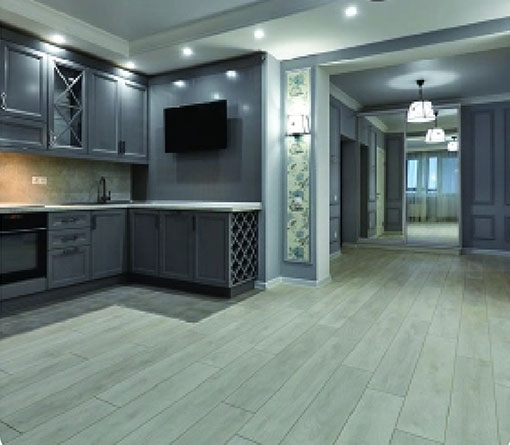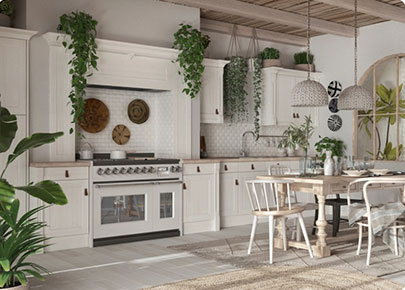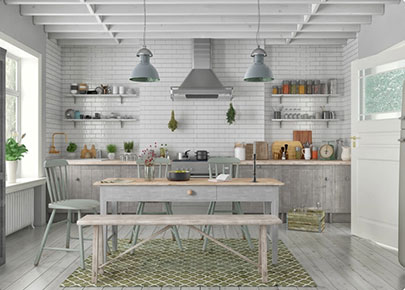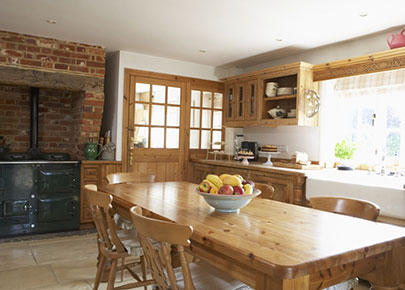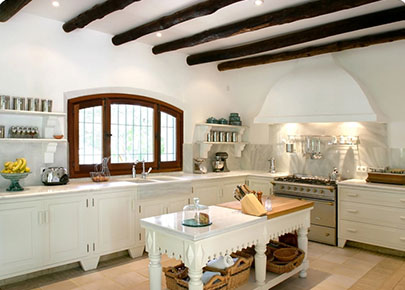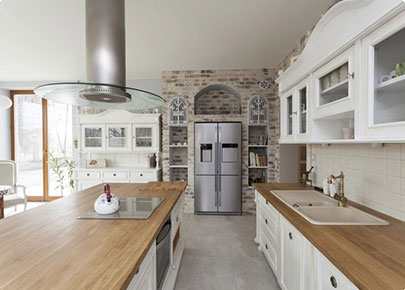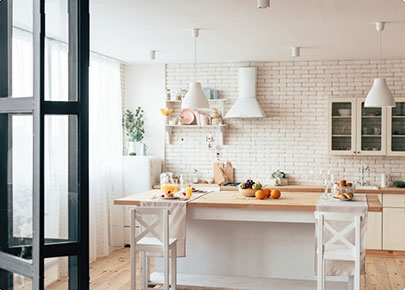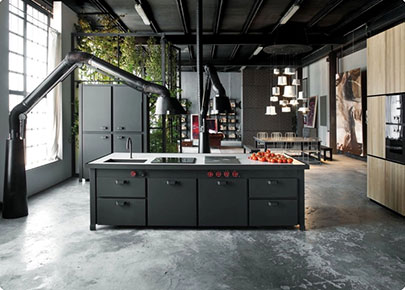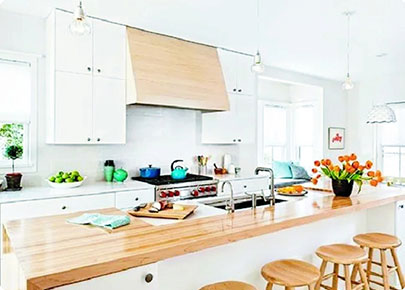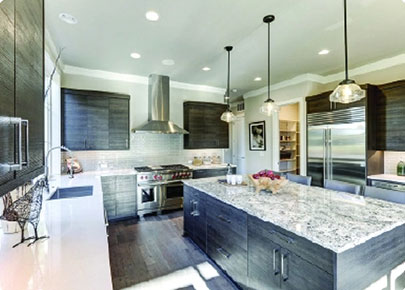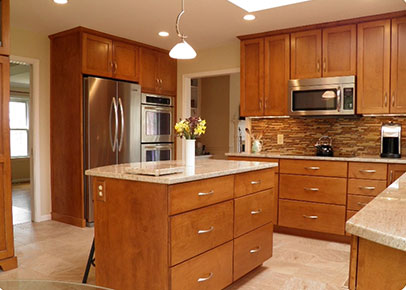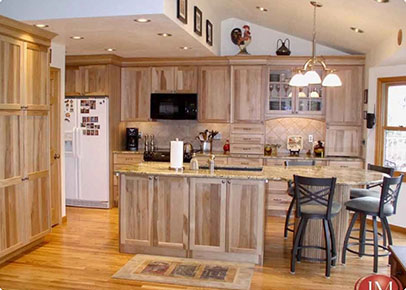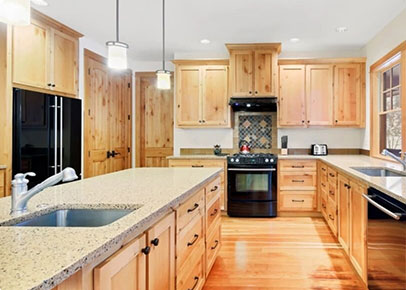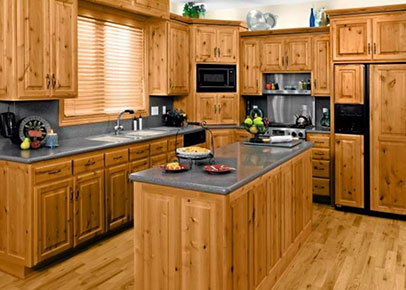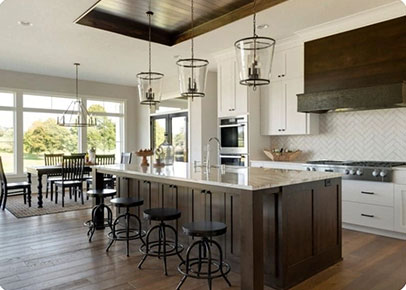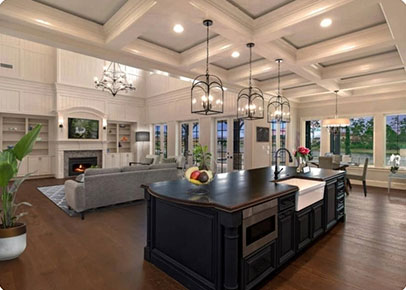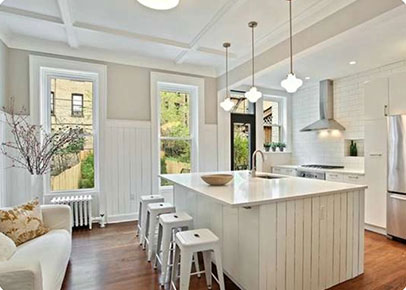Kitchen Styles
Your kitchen should be a space that matches your personality and fits your lifestyle. Before embarking on your kitchen renovation, deciding on what style of kitchen best suits your needs is a great first step.

Cabinets
Because they take up the largest part of your kitchen, the cabinets ultimately define the overall aesthetic of the space. While there are many styles and materials available, your kitchen cabinets must be sturdy, functional and installed properly.
Before making a decision, it’s a good idea to consider the types, categories and styles of cabinets that are available. The type of cabinet, its construction and door style will help determine what options are best suited for your needs.
Cabinet Materials:
Choosing the right material for your kitchen cabinets is one of the most important (and potentially difficult) decisions to make in any kitchen remodeling project. Aside from the way they will look, there are many other factors to consider. Each has its own pros and cons, so your decision should take into consideration how your kitchen will be used.
Solid Wood
Wood is extremely durable, long lasting and provides a natural aesthetic that you won’t find in other cabinet materials. Some woods (such as walnut and mahogany) are softer than others, so it's important to consider what types of wood will fit your needs.
Pros:
- Durable
- Eco-Friendly
- Sustainable
- Variety of Styles and Colors
- Repairs (can be sanded)
Cons:
- Expensive
- High Maintenance
- Heavy
- Prone to Stains
Premium Woods
Moderately Priced Woods
Plywood
Plywood is made by gluing thin layers of wood together. Available in different grades (AA, A, B, C, D and E) - the lower the grade, the more inconsistent in both quality and color. Since it is not strong, plywood is typically used in interior cabinet components.
Pros:
- Affordable
- Resistant to Temperature Fluctuations
- Made of Actual Wood
- Easy to Repair
- Visible Grain (when coated with a clear finish)
Cons:
- Prone to Damage
- Limited Finish Options
- Prone to Warping
Medium/High Density Fiberboard (MDF/HDF)
MDF/HDF is made by pressing and gluing wood fibers together. Has a smooth finish and a lack of wood grain.
Pros:
- Affordable
- Flat, Even Surface (can be painted)
- Will Not Warp
- Variety in Available Sizes
Cons:
- Durability (not as strong as solid wood or plywood)
- Porous (must be sealed properly)
- Difficult to Repair
- Prone to Damage (in high temperatures)
Laminate
Laminate is a smooth, synthetic plastic covering that can be applied on top of MDF or plywood. Comes in low pressure (less expensive, also known as Melamine) and high pressure (more durable, also called Formica and Wilsonart).
Pros:
- Affordable
- Low Maintenance
- Variety of Colors and Patterns
Cons:
- Difficult to Repair
- Cannot Be Painted
Metal
Historically only found in commercial kitchens, metal is now a popular choice for those looking for a sleek, clean, contemporary look.
Pros:
- Low Maintenance
- Easy to Clean
- Durable
- Water and Heat Resistant
Cons:
- Niche Style
- Difficult to Repair
- Prone to Damage (dents/scratches)
Cabinet Construction:
Framed
Has a frame that attaches to the front of the cabinet.- Clean border that accentuates the raised interior of the cabinet doors
- Face frame provides extra strength
- Found in traditional designs
Frameless
No face frame.- Offers extra storage space
Partial Overlay
The door partially covers the cabinet’s face frame.- Approximately 2” of the cabinet face frame is exposed between the doors.
- Often used to cut manufacturing costs
- Found in older homes
- Also known as “standard” or “traditional”
Full Overlay
The doors and drawer fronts almost completely cover the cabinet face.- Does not have a vertical face frame between the doors
- More expensive because more materials are used to manufacture them
- Enhances a transitional or contemporary style
Inset
The door and front sit inside the cabinet frame openings.- Expensive
- Quality craftsmanship
- Requires specialized hardware (to create a flush panel)
- Popular in traditional, transitional and craftsman style kitchens
Cabinet Door Styles:
Recessed (Shaker) Panel Cabinet
Cabinet doors and drawers have a flat surface with a recessed panel in the middle.
Pros:
- Modern Look
- Understated Aesthetic
- Variety of Hardware Options
- Widely Available
Cons:
- Harder to Install with Raised Humidity
- Requires Regular Cleaning
Raised Panel Cabinet
Features raised cut-outs that blend into the cabinet structure. A timeless/elegant style that adds dimension and depth.
Pros:
- Timeless/Elegant Aesthetic
- Decorative Variety
- Dimension (via the raised center panel)
- Easy to Clean
Cons:
- More Expensive (than recessed panels)
- Less Frameless Options
Slab Cabinet
Provides a truly minimalist/simple look. Also known as flat front or panel front.
Pros:
- Economical
- Low Maintenance
Cons:
- Can Look Plain
Glass Front Cabinet
Provides more storage space. Usually used in specific areas. Also known as open frame doors.
Pros:
- Can Include Lighting
- Showcases Valuables (glassware, dishes etc.)
- Alternative to Open Shelving
- Protects from Dust/Grease
Cons:
- Delicate
- Expensive
- Can Look Cluttered (if not tidy)
Beadboard Cabinet
Vertical slat cabinet fronts.
Pros:
- Adds Texture/Dimension
- Variety
Cons:
- High Maintenance (difficult to clean)
Inset Cabinet
Cabinet doors fit flush with the face frame for a smooth, clean look.
Pros:
- Classic Craftsman Aesthetic
- Personalization Options
Cons:
- Expensive
- Exposed Hinges
Depending on your budget, timeline and vision, kitchen cabinets are available in four different categories: Ready to assemble, stock (prefabricated), semi-custom and custom.
Ready to Assemble (RTA) Cabinets
The most affordable option, RTA cabinets are sold in large chain home improvement stores.
Pros:
- Economical
- Easy to Purchase
Cons:
- DIY Assembly
- Risk of Damage (when assembling)
- Limited Options (designs, finishes, styles, materials)
- Limited Longevity
- Mediocre Quality
Stock Cabinets
Ready-made and pre-manufactured (prefabricated).
Pros:
- Economical
- Wider Variety (such as detailing options)
- Variety of Materials (solid wood, melamine or particle board covered with laminate)
Cons:
- Limited Accessories
- Limited Sizes Available
- Fixed Size (other elements will need to be adjusted to the cabinets)
Semi-Custom Cabinets
A cross between prefabricated and custom cabinets. Offers the ability to create a more personalized space.
Pros:
- Quality
- Moderately Diverse Options
- Personalized Look
- Mid-Range Price
- Finished
Cons:
- Expensive (versus stock and RTA cabinets)
- Delivery Time
- Limited Modification Options
Custom Cabinets
If you are looking for a fully personalized space, custom cabinets are your best bet. Not only are they built to last, but custom cabinets guarantee your dream kitchen becomes a reality.
Pros:
- Superior Craftsmanship
- High Quality
- Functionality (no gaps or wasted space)
- Fully Customized
- Diverse Materials, Finishes, Accessories
- Optimized Storage/Organization/Funcion
Cons:
- Most Expensive Option
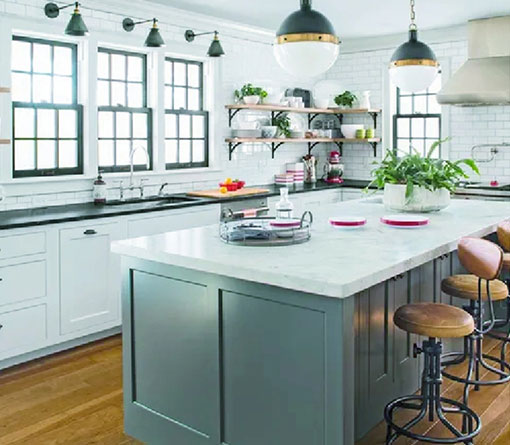
Countertops
Kitchen countertops are often the design element that ties the entire space together. Not only is it an investment that will last many years, your countertops should be functional and fit in seamlessly with the cabinets, flooring and other design features. Replacing kitchen counters is one of the most popular home improvement projects because it will bring new life into the kitchen.
Types of Countertops:

Wood Countertop
Wood countertops, such as Butcher Block, can provide the look of high quality without the high price tag. This is a great option for anyone looking to achieve an organic aesthetic. Wood is also naturally durable and is considered a renewable resource. Wood countertops are sometimes coated with acrylic paint before installation because it makes them waterproof, stain-resistant and easy to clean.
Types of wood used in manufacturing countertops include maple, teak, cherry, walnut and reclaimed wood.
Pros:
- Eco-Friendly
- Sustainable
- Easy to Refinish/Repair
- Variety
- Less Expensive (versus stone)
Cons:
- Flammable
- Specific Maintenance Requirements
- May Warp/Crack (over time)
- Exposure to Sunlight (can cause yellowing)
- Specialized Installation
- Can Splinter
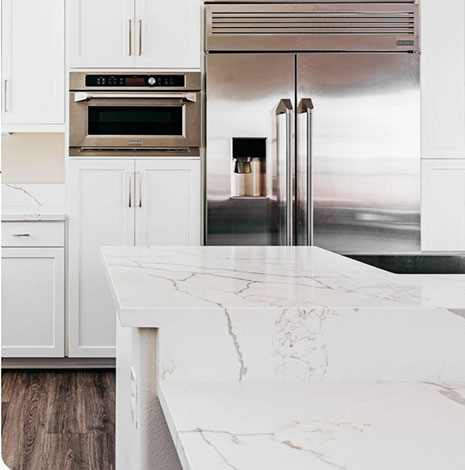
Natural Stone Countertops
The use of natural stone is one of the most common kitchen countertop materials used today because it can stand up to the daily exposure and burdens of use. Due to the natural variations in patterns, colors and textures, every countertop is unique.
The most popular natural stone materials are granite, marble, slate, limestone, travertine, lavastone and soapstone.
Pros:
- Durable
- Long-Lasting
- Natural Aesthetic
- Heat Resistant
Cons:
- Expensive
- Naturally Porous (must be sealed when installed)
- Damage (softer stones can chip)
- Susceptible to Stains
- Specialized Installation

Engineered/Cultured Stone Countertop
Engineered stone is a composite material created of resins and natural stone (typically quartz). Because of the high percentage of quartz, the surface is more durable than natural stone and is available in a variety of patterns and styles, including uniform colors. This is a great option for those who prefer to use recycled materials or desire to protect natural resources.
Types of engineered stone include silestone, quartzite, Dekton, terrazzo, paperstone and porcelain.
Pros:
- Variety of Options
- Low Maintenance
- Hygienic
- Eco-Friendly
- Resists Heat
- Stain Resistant
Cons:
- Expensive
- Specialized Installation
- Very heavy

Concrete Countertops
Concrete has become a popular material option for countertops because of its organic aesthetic which complements other organic components in the space (e.g., metal and wood). Concrete can be poured into any size and shape and can be inlaid with other materials to create texture.
Pros:
- Economical
- Durable
- Versatile
- Easily Repaired
- Heat and Stain Resistant (when stained/sealed properly)
Cons:
- Maintenance (must be sealed often)
- Prone to cracks, stains and chips

Recycled Glass Countertop
A recycled glass countertop can literally transform your kitchen into a work of art. Eco-friendly, sustainable and durable, recycled glass can be found in any color ranging from vibrant colors to neutral tones. The countertop is made by mixing clear acrylic or concrete with recycled glass shards.
Pros:
- Eco-Friendly
- Sustainable
- Durable
- Versatile
Cons:
- Can Stain
- Specialized Installation
- Expensive
- Prone to Damage (can chip or crack under heavy weight)

Metal Countertops
Metal countertops have become one of the most popular kitchen countertop trends in recent years. They are also one of the most environmentally friendly materials available and are more durable than other countertop materials such as granite or marble.
Types of metal countertop materials include stainless steel, copper (hammered/polished), aluminum, bronze, pewter, zinc and recycled metal.
Pros:
- Versatile
- Aesthetic Appeal
- Low Maintenance
- Hygienic
- Durable
- Resistant to Heat
Cons:
- Expensive
- Susceptible to Damage (dents, scratches etc.)
- May Tarnish (over time)
- Difficult to Repair
- Noisy
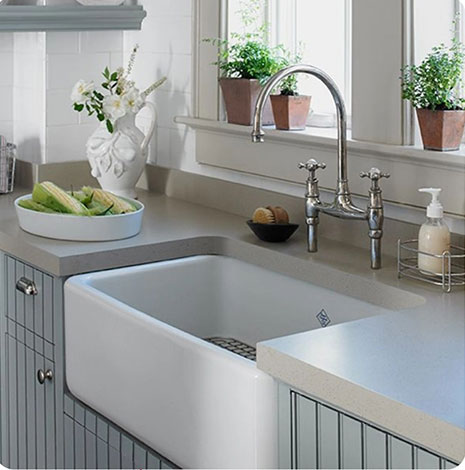
Solid Surface Countertop
Solid surface countertops are made to mimic the look of natural stone without the high price or required maintenance. Sold under various brand names (such as Corian or Swanstone), solid surface countertops are made from acrylic and polyester blends which make them nonporous and difficult to stain. Many homeowners opt for this material because they can be created into any size, shape or color.
Pros:
- Durable
- Low Maintenance
- Easily Repaired
- Variety of Options
- Invisible Seams
- Budget-Friendly
- Versatile
- Easily Customized
Cons:
- Susceptible to Damage (scratches, dents etc.)
- Heat (can be scorched)
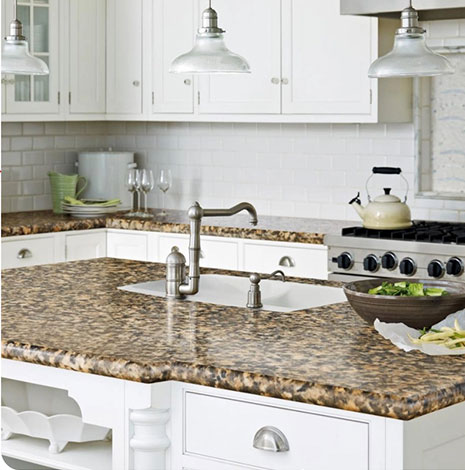
Laminate Countertop
If you are looking for an affordable option, a laminate countertop is a great way to achieve a polished look without the price tag of other countertop materials. Unlike the laminate countertops of yesteryear, today’s laminates (such as Formica, Wilsonart, Arborite) are significantly better. Outside of being the most affordable option, laminate is very durable and is available in a wide variety of colors and styles.
Pros:
- Budget-Friendly
- Variety of Options
- Low Maintenance
Cons:
- Shorter Lifespan
- Susceptible to Damage
- Difficult to Repair

Islands
There is a reason why kitchen islands are the most popular “must have” in any kitchen renovation: they provide additional counter and cabinet space and offer more return than any other kitchen upgrade.
A kitchen island is essentially a detached piece of cabinetry traditionally considered solely as a place to prepare food. However, many homeowners are now opting to replace breakfast nooks and kitchen tables with a well designed kitchen island because it affords them additional counter and storage space. While conventional kitchen islands are rectangular in shape, it is now common to find them in a variety of shapes, sizes and styles to fit in virtually any space.
At Honey Do Men, we understand how overwhelming it can be because the choices seem to be endless. Updating your kitchen is a long-term investment and should provide you with a space you love to be in. We offer customers an impressive selection of options for every budget, style or design.
As the heart of your home, we will work with you to create a project plan that will create the kitchen of your dreams.
Kitchen Island Functions

Mobility
Moveable carts with lockable casters are great options for small kitchens because they can be moved anywhere.
Pros:
- Budget-Friendly
- Mobile (can be moved when not in use)
- Versatility (can be used for anything)
Cons:
- Small Workspace
- Wheels (can be damaged and/or unlocked)
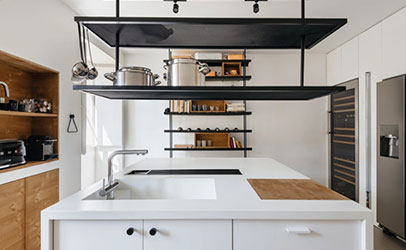
Storage
At its most basic, an island provides additional counter and cabinet space and often contains shelving for cookbooks or other items.
Pros:
- Simple Design
- Aesthetically Appealing
- Versatility
- Smaller Size (good for small kitchens)
Cons:
- Heavy (difficult to move)
- Limited Workspace

Working
Styled after vintage worktables, a working island consists of an open bottom shelf (for baskets, crates etc.) and a countertop supported by four legs. Essentially a countertop with no storage.
Pros:
- Versatility (can be used for homework, eating, prepping etc.)
- Budget Friendly
Cons:
- No Storage
- Style/Design (may not match cabinets)
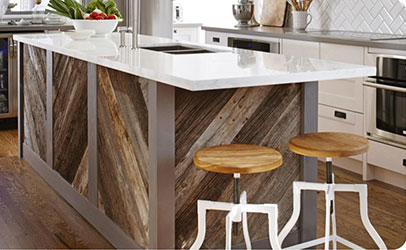
Base Cabinet and Countertop
Built from existing cabinets with a countertop affixed to the top. These types of islands are usually anchored to the floor.
Pros:
- Versatility
- Aesthetics (can match or complement cabinets)
Cons:
- Countertop (must be cut to size)
- May Require Electricity (based on building codes)
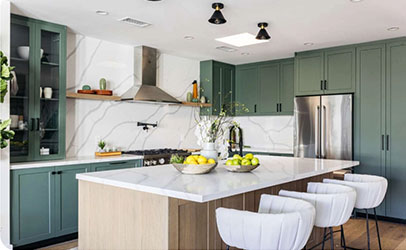
Prep and Wash
Islands that feature a sink are great for those who entertain frequently (for washing hands, rinsing vegetables or bartending). This type of island requires additional plumbing.
Pros:
- Versatility
- Adds Home Value
- Expanded Workspace
Cons:
- Expensive
- Requires Electric and Plumbing
- Difficult to Replace
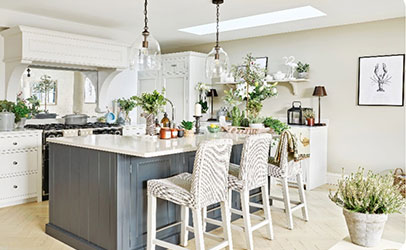
Dining/Cooking
Features an overhanging counter for casual dining or entertaining. Enables the chef to interact with guests and is a combination of two functions. Ideal for family kitchens.
Pros:
- Functionality
- Adds Home Value
- Versatility
Cons:
- Expensive
- Requires Ventilation
- Requires Extra Hook-Ups (electrical etc.)
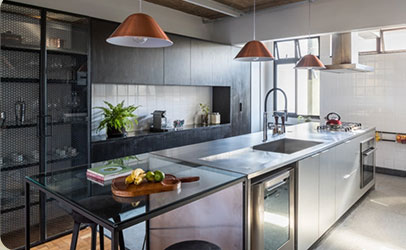
Fully Functional
A fully functional island consists of everything a kitchen counter can do: plumbing, appliances (e.g., wine refrigerator), electric, sink, drainage, counter space etc. Ideal for people who entertain in a large space.
Pros:
- Adds Home Value
- Aesthetically Appealing
- Expanded Work Space
Cons:
- Expensive
- Plumbing (must be connected to main line under the floor)
- Fixed (future remodeling projects may be difficult)
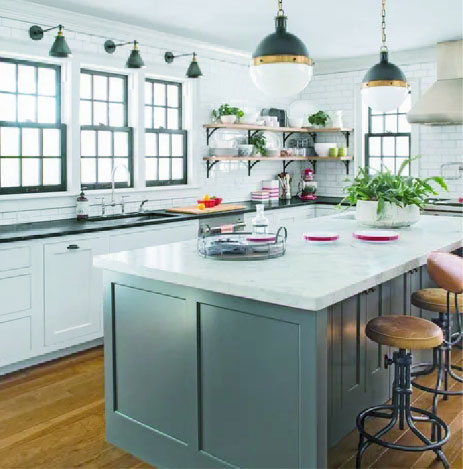
Lighting
The lighting in your kitchen is a great example of one size does not fit all because it does much more than simply illuminating the space. The right balance of lighting is one of the most challenging aspects of kitchen design because it serves multiple purposes.
In fact, most homeowners combine a variety of fixtures, each fulfilling a different purpose. In other words, if you are looking to maximize the function and aesthetics of your kitchen (and your entire home), a single light fixture will not suffice.
The lighting in your kitchen is a great example of one size does not fit all because it does much more than simply illuminating the space. The right balance of lighting is one of the most challenging aspects of kitchen design because it serves multiple purposes. In fact, most homeowners combine a variety of fixtures, each fulfilling a different purpose. In other words, if you are looking to maximize the function and aesthetics of your kitchen (and your entire home), a single light fixture will not suffice.
In general, each lighting fixture in your home serves at least one of three general purposes:

Ambient Lighting
Provides overall illumination and is meant to create a uniform level of lighting. Not ideal to showcase specific elements. Often dimmable to accommodate day and nighttime settings.
- Ceiling Mounted Fixtures
- Floor Lamps
- Recessed Lighting That Direct Light Downward
- Wall Sconces
- Pendant Lights
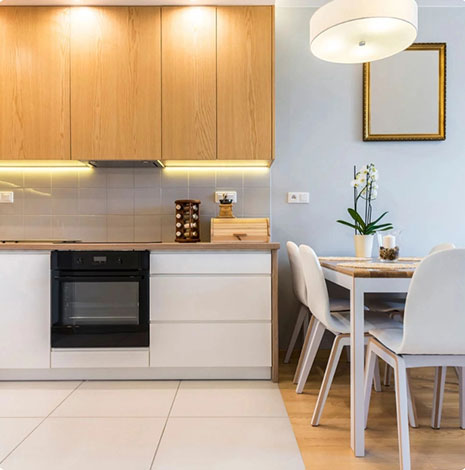
Task Lighting
Light focused on a particular area to increase visibility where a task is performed. Direct, intense illumination for detailed work (such as food preparation).
- Under Cabinet Lighting
- Pendant Lights
- Recessed Lighting
- Recessed Lighting
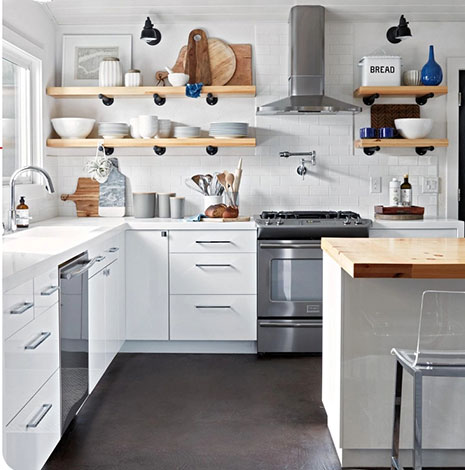
Accent Lighting
Primary objective is to create an aesthetically pleasing atmosphere and a focal point of interest. Intended to highlight a specific feature (such as artwork, architectural details, furnishings etc.) and typically provide brighter illumination.
- Recessed Spot Lighting
- Wall-Mounted Painting Lights
- Track Lighting
- Wall Sconces
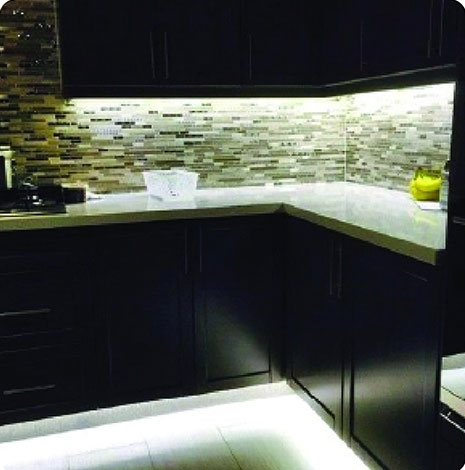
Ceiling Light Fixtures
In the kitchen, ceiling fixtures act as the primary source of lighting because they are made to cast as much light down from the ceiling to illuminate the space. The use of multiple fixtures will allow light to penetrate the entire kitchen.
Keep in mind the height of your ceiling and the location of the light fixture to prevent injury or damage. Many of today’s lighting fixtures are adjustable so that they can provide optimal functionality.
Recessed Lights
The most common type of lighting found in any modern kitchen. Recessed lights are spaced approximately 5’-6’ apart from each other and are built into the ceiling.Directional Recessed Lights
Adjustable and can be used to beam at specific features in the space.Track Lights
Affixed to the ceiling with multiple bulbs that each illuminate a specific area. Can be angled in multiple directions.Pendant Lights
Hang from the ceiling to bring the light closer to specific areas to provide better visibility. Typically used over kitchen islands.Chandeliers
Used to create a luxurious aesthetic. Typically made from crystal or glass and installed over kitchen islands.Cabinet Lighting Fixtures
As the name suggests, cabinet lighting illuminates areas that are typically limited to light. Many homeowners decide to use cabinet lighting because they create visual warmth and draw attention to the intricate details of the cabinets themselves.In-Cabinet Lights
Light fixtures installed inside glass cabinets can be used for both daytime and nighttime, controlled with a dimmer switch for optimal ambiance.Under-Cabinet Lights
Either run the length of the cabinets or contained in small, individual puck-sized fixtures.Toe-Kick Lights
Lighting beneath the bottom cabinets to illuminate walking paths and defines spaced with a softer intensity.Other Types of Lighting Fixtures
Today’s homeowners have many kitchen lighting options to choose from. Regardless of what purpose you are looking for the lighting in your kitchen to serve, there is something for everyone.Wall Sconces
Can provide ambient, task, and accent lighting. Wall sconces are typically ornamental in purpose.Accent Lighting
Used to draw attention to a specific item or area to add visual appeal.Decorative Lighting
Ornamental in function. Usually dramatic, meant to draw attention.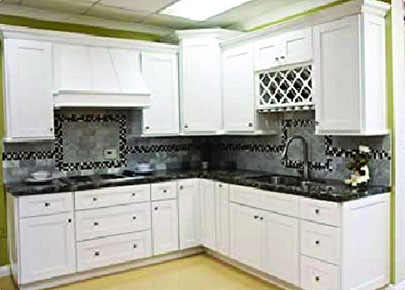
Backsplashes
The backsplash is often one of the last elements considered, yet no kitchen remodel would be complete without it. While its primary purpose is to protect the walls, a backsplash should complement the kitchen’s overall style and design. Whether you are looking to make a statement or use a more subtle approach, the backsplash is an invaluable part of your kitchen’s overall aesthetic.

Ceramic Tile Backsplash
Ceramic tile is the most popular choice of backsplash materials. There are literally thousands of possibilities and design options available. The tiles are created by firing and glazing wet clay. Tile prices will vary based on the size, thickness and quality of materials used to create them.
Types of ceramic tiles include: Subway, penny, mosaic, hand-painted, crackle-glazed, herringbone and more.
Pros:
- Easy Maintenance
- Budget-Friendly
- Wide Variety of Options
- Easy to Replace
- Versatile
Cons:
- Can Stain (tiles and grout)
- Potential Cracking (over time)
Keep in mind that if you decide to use smaller tiles, they will need more grout, which will be difficult to clean and maintain. In addition, it’s a good idea to keep extra tiles on hand in the event any tiles need to be replaced.
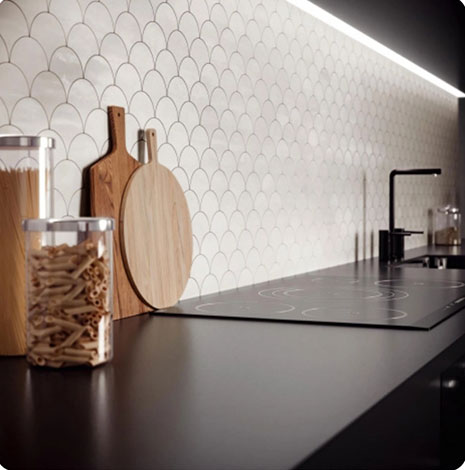
Porcelain Tile Backsplash
Like ceramic tiles, porcelain is a great option for anyone looking for a low maintenance backsplash. Unlike ceramic tiles, porcelain tiles are not glazed. They are manufactured from compressed clay dust fired at high temperatures.
Pros:
- Durable
- Sealing Not Required (porcelain is water resistant)
- Doesn’t crack
- Less maintenance than ceramic tiles
Cons:
- More Expensive (than ceramic tiles)
- Less Variety
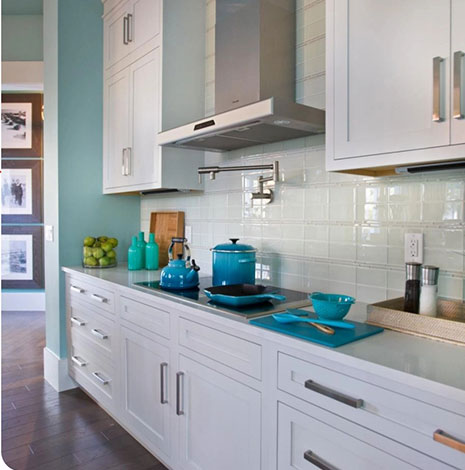
Glass Tile Backsplash
Because glass can be created into any color, shade or style imaginable, many homeowners choose this material because they are able to add their personal creative imprint into the space. From contemporary design to traditional charm, the use of glass tile is a great option for anyone looking to create a one-of-a-kind look (can also be used to accent more traditional porcelain and ceramic tile backsplashes).
Pros:
- Low Maintenance
- Wide Variety of Options
- Can Add Home Value
Cons:
- Expensive
- Can Reflect Sound
- Difficult to Replace (matching tiles may be difficult/impossible to find)
- Translucent (can show flaws in glass)
Keep in mind that glass tiles are heavy, so the walls may need to be reinforced before installation.
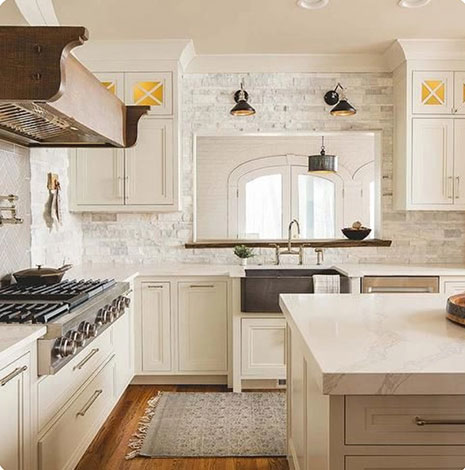
Stone Tile Backsplash
Stone tiles are a great option for anyone looking for an organic look. Natural stone can offer textures and dimensions not possible with ceramic, porcelain or glass tiles. The quality and type of stone used and backsplash design will all affect the price. There are several types of stone tiles commonly used in backsplashes including: Granite, slate, soapstone, quartz, travertine, marble, engineered stone and limestone.
Pros:
Durable Wide Variety of Options Adds Home ValueCons:
- Higher Maintenance (must be sealed annually)
- Softer Stones Can Be Scratched (e.g. soapstone)
- Difficult To Repair
- Heat Damage (some stones are susceptible to damage from high temperatures)
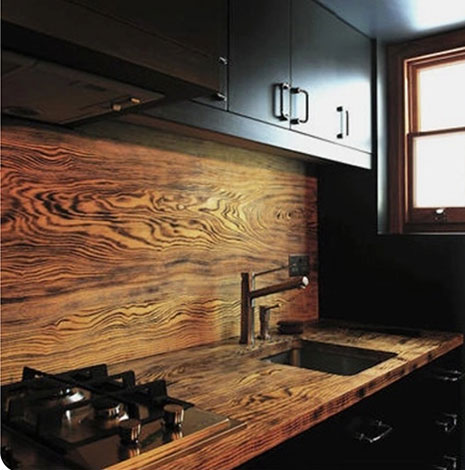
Wood Backsplash
As an all natural material, a wood backsplash offers an organic aesthetic as an alternative to the more traditional types of backsplash materials. Wood can be easily recycled and reused and comes in a wide variety of graining, surface, finish and color options.
Types of wood backsplashes include: Shiplap, beadboard, reclaimed wood etc.
Pros:
- Affordable
- Versatile
- Lightweight (versus stone or tile)
- Durable
- Workability (can easily be cut to fit different sizes and shapes)
- Easily Replaced
Cons:
- High Maintenance
- Combustible
- Can Buckle or Warp
- Wearing (over time)
Keep in mind that wood is not naturally water or fire proof, so it is vulnerable to damage if not laminated or sealed properly.
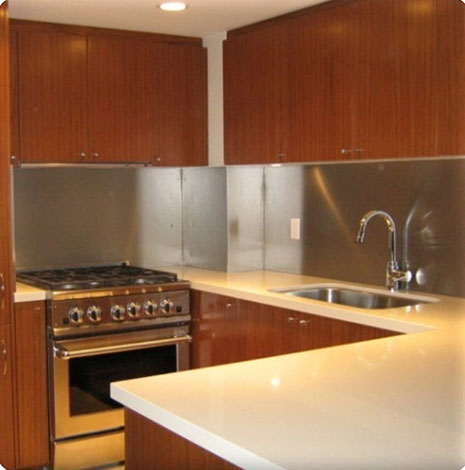
Stainless Steel/Metal Backsplash
Due to the fact that metal is durable and easy to clean, it is becoming a very popular option for homeowners looking for a sleek, contemporary look. A metal backsplash can be designed in a variety of patterns, is available in textured form and can be combined with other materials.
Pros:
- Easy to Maintain
- Reflects Light
- Won’t Stain
- Easy to Clean
Cons:
- Prone to Damage (dents, scratches etc.)
- Difficult to Install
- Shows Streaks (fingerprints, grease splatters etc.)
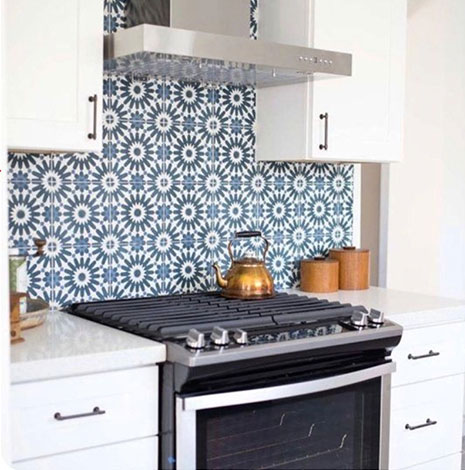
Cement Tile Backsplash
Cement tiles have been around for centuries because they are versatile, durable and come in a myriad of styles and colors. Unlike ceramic tiles which normally have a layer of glaze and are fired in high temperatures, cement tiles are cured at room temperature (not fired), and the colored layer on top is porous.
Pros:
- Versatility
- Variety
- Porous (over time the patina can enhance the appearance)
Cons:
- Difficult to Install
- High Maintenance
- Heavy
- Stains Easily
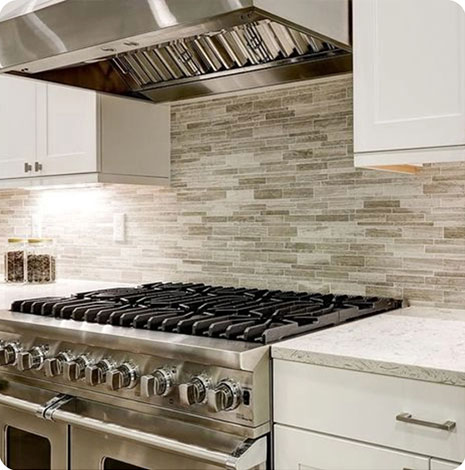
Peel and Stick Tile Backsplash
As the name suggests, peel and stick backsplashes consist of an adhesive that is applied directly to the wall. Typically made from vinyl, adhesive tiles also come in materials such as stone, metal and glass.
Pros:
- Budget Friendly
- Versatility
- Wide Variety of Styles
Cons:
- Temporary
- Installation (can look sloppy if not installed properly)
- No Added Home Value
- Can Peel (in high heat or moisture)

Wallpaper Backsplash
Wallpaper has made a comeback in recent years thanks to the innovation of exciting colors, patterns and textures. Like peel and stick tiles, wallpaper is a budget-friendly backsplash option that is a great way to add dimension and style to any space.
Pros:
- Visually Appealing
- Low Maintenance
- Budget Friendly
Cons:
- No Added Home Value
- Can Peel (in high heat or moisture)
- Installation (can look sloppy if not installed properly)

Chalkboard Paint
Chalkboard paint is a great option for those looking for a more creative aesthetic. Many choose this option because it can be used for writing recipes, doodling or to-do lists.
Pros:
- Budget Friendly
- Creative
- Customizable
- Easily Replaced
Cons:
- Dust (from erasing)
- Color (can make room look smaller)
- Longevity (doesn’t last as long as other materials)
We know how daunting it can be to decide on what backsplash material is the best option for your kitchen. Honey Do Men will work with you every step of the way and will help you create a visually appealing, functional backsplash that will enhance the overall aesthetic of your kitchen.

Flooring
New or replacement flooring is an investment meant to last, so extra care should be taken when making any flooring decision. Yet, choosing the best type of flooring for your kitchen can seem overwhelming because there are so many available options to choose from. Your kitchen floors should not only look beautiful, but they have to stand up to the stress of everyday use.
- Ceramic Tile
- Porcelain Tile
- Travertine Tile
- Slate Tile
- Marble Tile
- Glass Tile
- Cork
- Bamboo
- Granite Tile
- Cement Tile
- Poured Cement
- Onyx Tile
- Quartzite Tile
- Sandstone Tile
- Pebble Tile
- Floating Wood
- Rubber Tile
- Medium Hardwood
- Light Hardwood
- Dark Hardwood
- Vinyl
- Limestone
- Terra-Cotta Tile
- Linoleum
- Laminate
- Painted Wood
- Brick
- Terrazzo
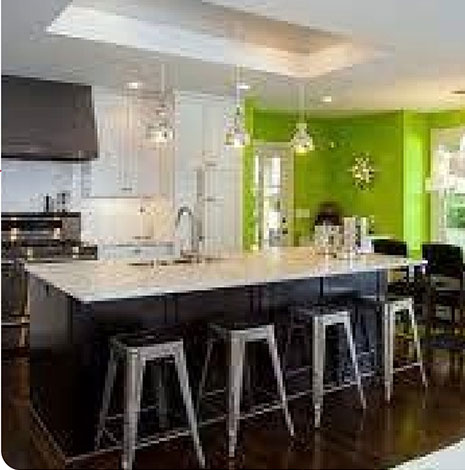
Accent Walls
While the kitchen is ultimately a functional space, it is also a place of gathering and is likely the most used room in the home. Accent walls are an affordable way to add a pop of personality and maximize the limited usable space for a visually engaging statement.
- Paint
- Brick Veneer
- Mirrors
- Wallpaper
- Paneled Wood
- Chalkboard Paint
- Vinyl Decals
- Cement
- Natural Stone
- Stainless Steel
- Ceramic Tile
- Mosaics
- Wood Cladding
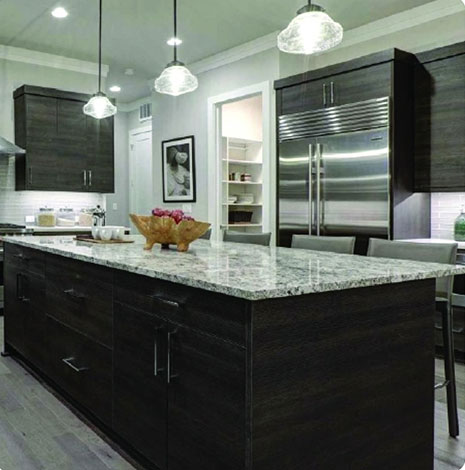
Ceilings
Aside from its integral role of supporting your home’s interior walls, the ceiling in your kitchen can greatly affect the room's entire aesthetic and ambiance. A creatively designed and properly installed ceiling is something many homeowners overlook, but can truly enhance your home’s appeal.

Hardware
While kitchen hardware is designed to protect your cabinets from being damaged, they also serve a decorative purpose. In fact, your kitchen’s hardware is the perfect example of the large impact the small details can make.
- Pot/Pan Hangers
- Bar Handles
- Bow Handles
- Knobs
- Cup Handles
- Edge Profile
- Handle Pulls
- Cut-Outs
- Custom
- Bronze
- Brushed Brass
- Brass
- Distressed
- Flat
- Stainless Steel
- Satin Nickel
- Aluminum
- Antique Finish
- Ceramic
- Chrome
- Glass
- Crystal
- Brushed Finish
- English Brass
- Vintage
- Long Bold Pulls
- Copper
- Colonial Bronze
- European
- Traditional
- Transitional
- Contemporary
- Iron
- Marble
- Plastic
- Porcelain
- Resin
- Wood
- Zinc
- Matte-Oil Rubbed
At Honey Do Men, we understand how overwhelming it can be because the choices seem to be endless. Updating your kitchen is a long-term investment and should provide you with a space you love to be in. We offer customers an impressive selection of options for every budget, style or design.
As the heart of your home, we will work with you to create a project plan that will create the kitchen of your dreams.



